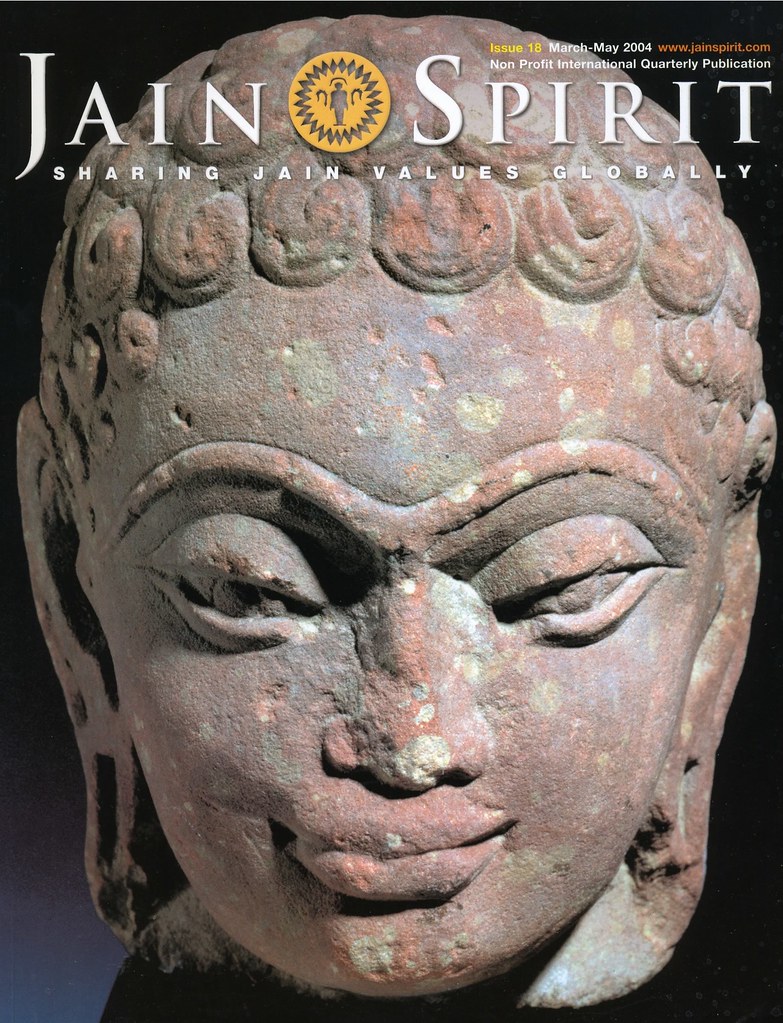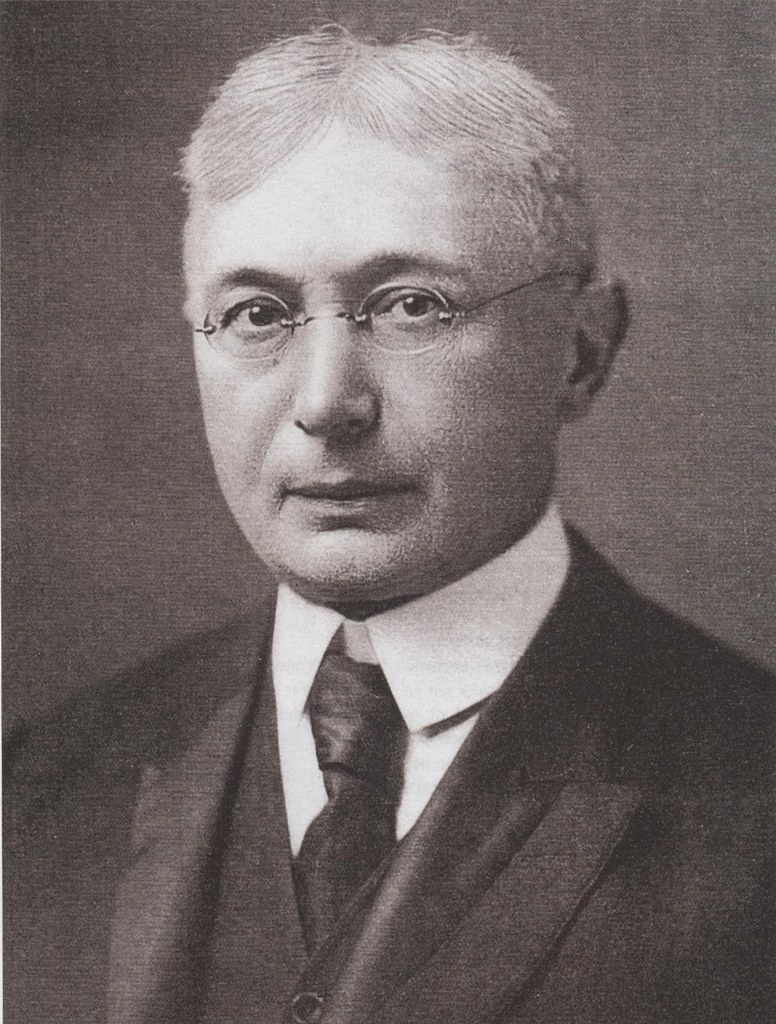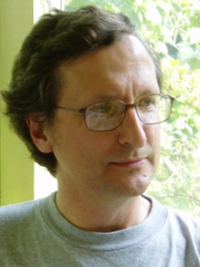 Jain Spirit magazine - A non-profit International Quarterly Publication - #18 (2004-2). Photo - Bridgeman Art Library: Jain Head, 6th century AD, Mathura region, India.
Jain Spirit magazine - A non-profit International Quarterly Publication - #18 (2004-2). Photo - Bridgeman Art Library: Jain Head, 6th century AD, Mathura region, India.Maurice Bloomfield, The First American Scholar Of Jainism
 The First American Scholar Of Jainism
The First American Scholar Of JainismJohn Cort Analyses The Pioneering Contribution Of A Unique Academic
The early study of the Jains took place in Great Britain, Italy, France and especially Germany. British studies were made largely within the context of the imperial rule of India. Authors such as Major James Delemaine, Lieutenant-Colonel William Miles, W. Franklin, H. T. Colebrooke and H. H. Wilson were involved in the establishment of imperial control over India. Their interests were social, thus their studies of Jainism focused primarily on the Jains as comprising a set of related castes within the broader framework of Indian society. Their writings also included a smattering of loosely connected observations concerning Jain history, architecture and literature. The Presbyterian missionary Reverend J. Stevenson, who lived in Gujarat, translated several Shvetambara scriptures into English. James Burgess had perhaps the best understanding of the Jains of the early British authors; through his extensive work he documented Jain temples for the Archaeological Survey of India.
It was in Germany that the intellectual foundations for Jain studies were laid. In the period from the middle of the nineteenth century through the first one-third of the twentieth century, Albrecht Weber, Georg Biihler, Hermann Jacobi, A. F. Rudolf Hoernle, Ernst Leumann and Helmuth von Glasenapp provided Western scholarship with an invaluable outline of Jain history, and particularly an understanding of the early Shvetambara scriptures. Other scholars on the Continent, such as F. L. Pulle, Luigi Suali and Luigi Pio Tessitori in Italy, A. Guerinot in France and J. Charpentier in Sweden were important collaborators with the Germans in this early exploration of Jain literature.
The absence of any American scholar in this roster is noteworthy. Virchand Gandhi had come to the United States in 1893 to attend the World Parliament of Religions in Chicago. He was one of a handful of Asian speakers who contributed to the historical importance of that gathering. Gandhi went on a speaking tour in the Midwest and East of the United States before returning to India, but his visit made no lasting impact upon American study of the Jains. Even though his address to the Parliament was easily available in the printed proceedings, there is no evidence of American scholars using it in their scholarship. Americans came rather late to the study of the Jains. While the past two decades has seen a flurry of North American scholarship on Jainism, this is a decidedly recent phenomenon. It is not built upon any sustained earlier tradition of American Jain studies.
The first American scholar to turn his attention to the Jains was the Sanskritist and Linguist Maurice Bloomfield. He was born in Central Europe in 1855, and his family migrated to the United States four years later. He studied at the University of Chicago and Furman University before going to Yale to study Sanskrit under William Dwight Whitney. Whitney was one of the American pioneers in Sanskrit studies and generations of American students have relied on the two textbooks he wrote in the 1880s: Sanskrit Grammar and Roots, Verb-Forms and Primary Derivatives of the Sanskrit Language.
Bloomfield did not stay at Yale. He transferred to Johns Hopkins University in Baltimore. For many years Johns Hopkins was a centre of Sanskrit teaching and scholarship in the United States. There he studied under Charles R. Lanman, another of the founding fathers of the teaching of Sanskrit in America. Lanman's 1884 Sanskrit Reader is also well-known to American students of Sanskrit. Bloomfield received his Ph.D. in 1879 for a dissertation on noun formation in the Rig Veda. He then went to Germany, where he engaged in advanced studies in classical Indian languages for two years in Berlin and Leipzig. Among his teachers was Albrecht Weber, one of the leading European scholars of the Jains.
Bloomfield returned to Johns Hopkins in 1881 to take up the position of Professor of Sanskrit and Comparative Philology. In addition to teaching Sanskrit, he also taught Pali, the language of the earliest Buddhist scriptures. Further, Bloomfield was perhaps the first American to teach Jain Maharashtri Prakrit.
Bloomfield's early work was in the fields of Vedic studies and comparative linguistics. He is still recognised as one of the leading Western scholars of Vedic language and religion. His 1906 Vedic Concordance remains an indispensable resource in the field. He published three substantial studies of the Atharva Veda that are essential starting points for any study of this 'fourth Veda'. His 1897 translation of Hymns of the Atharva Veda appeared in the prestigious Sacred Books of the East series. Two years later he published a critical edition of the Atharva Veda in the Grundriss der indo-arischen Philologie und Aitertumskunde, one of the leading Continental series of Indological scholarship. Finally, in 1901 he and Richard Garbe of the University of Tuebingen published a three-volume critical edition of the Pippalada recension of the Atharva Veda.
Later in his career Bloomfield developed an interest in what he called 'Hindu fiction", by which he meant all of the literatures of traditional India. The early twentieth century was the time of the rise in both Europe and North America of folklore studies, and for Bloomfield the study of Indian literature was a way to study folklore. This interest brought him into Jain studies, for the medieval Jain narrative literature is one of the principal repositories of Indic stories. Between 1913 and his death in 1928 he published over a dozen lengthy studies of various motifs in Indic story literature. Some of these appeared in scholarly books of essays in honour of other scholars, while most of them were published in leading scholarly journals. These included The American Journal of Philology; The Journal of the American Oriental Society; The Proceedings of the American Philosophical Society and The Transactions of the American Philological Association.
Each of these articles included material from Jain sources. Bloomfield knew all of the European scholarship on the Jains, which were mostly translations and studies of Jain texts. While European scholars focused on the earliest Shvetambara scriptures, some of them also published lengthy studies on medieval philosophical and narrative texts. He also had access to Jain texts published in India. This was a period when several Shvetambara Murtipujak monks such as Acharya Vijay Anandsuri (1837-1896, better known as Atmaramji) and Acharya Vijay Dharmsuri (1868-1922) were encouraging their monastic disciples to study and edit many Jain texts, which were not as yet well known, and also encouraging their lay followers to fund the publication of the resulting critical editions of the texts. Bloomfield never travelled to India - nor did most of the Western scholars of Sanskrit at that time - but he was thoroughly abreast of scholarly activities on Jainism there.
In his interlinking studies, he investigated the permutations of a series of distinct folklore motifs in a wide range of Brahmanical, Buddhist, Jain and folk narrative literature. Among the analyzed literary motifs were talking birds, the consequences of accidentally overhearing conversations, entering another person's body, women's pregnancy cravings, stealing, organised brigandage and false ascetics and nuns. In many stories, a parrot or other bird that can mimic human speech overhears what a human character thinks is a confidential message. The plot of the story takes a radical turn when the bird repeats the message in the hearing of another human character. Closely related to this is the motif of an accidentally overheard conversation, which can result in similarly unexpected outcomes. A third way in which stories take a dramatic turn is when one character enters the body of another. Stories involving women's pregnancy cravings can involve the husbands undertaking actions they would normally shun as they seek to satisfy their pregnant wives' requests for unusual food. Many Indian stories describe the activities of organised brigands, reminding us that travel has not always been as safe as it is nowadays. These stories sometimes overlap with many stories that describe the mischievous deeds of false monks and nuns. Such stories served as valuable social function for teaching people of the need always to test whether or not someone who appears to be a monk or nun is really who he or she claims to be. While the majority of renouncers in Indian history have been legitimate spiritual seekers, every generation has seen its fair share of rogues and fakes.
In these studies Bloomfield did not treat Jain literature as separate or distinct from Hindu, Buddhist and folk literatures. Instead, he saw them all as overlapping parts of a pan-Indian 'ocean of story'. Jain literature occupies a central place in such a study, for, as the German scholar Johannes Hertel observed in 1922, "during the middle ages down to our days the Jains were the principal story tellers of India."
An important result of Bloomfield's research into medieval Indian narrative literature was in 1919 'The Life and Stories of the Jaina Saviour Parsvanatha', published by the Johns Hopkins University Press. This was the very first book on Jainism published in the United States. It has been reprinted only once, in 1984 by a small publisher in Delhi. As a result, today it is unfortunately only available in specialised research libraries. In this book Bloomfield gave a detailed synopsis of the fourteenth-century Parsvanatha Charitra of the Shvetambara monk Bhavadevasuri. In medieval times the telling of the life of Parsvanatha expanded to include the telling of the previous lives of both Parsvanatha and his foe Kamatha. This extended biographical frame allowed Bhavadevasuri to explain in great detail the workings of karma. Deeds, words and thoughts in one life are shown to bear karmic fruit over many future births in hellish and heavenly realms, as animals and as humans. Many of the stories in the biographies of Parsvanatha are distinctively Jain, and not found in any other literary milieus of medieval India. But many other stories are shared with other literary traditions in India. They are found in Hindu and Buddhist literature and folk literature. Bloomfield well understood that the study of Jain narrative literature is essential for an adequate understanding of medieval Indian literature. Bloomfield accompanied his 155-page digest of the text with detailed notes on the various literary motifs, proverbs and linguistic issues raised by the text.
In 1923, four years after The Life and Stories of the Jaina Saviour Parsvanatha, Bloomfield published another study devoted exclusively to Jain literature. This was a lengthy synopsis of the thirteenth-century Shalibhadra Charitra by the Shvetambara monk Dharmakumara, which he published in the Journal of the American Oriental Society. This is a well-known story of the karmic fruits of donation (dana) of food to a monk. Due to such auspicious karmic fruits, the merchant prince Shalibhadra was able to renounce the world during the lifetime of Mahavir and attain liberation. As Bloomfield pointed out, donation is one of the four virtues of a pious Jain householder, and Jain texts in particular focus on the donation of food to a monk. This should not surprise us, especially when one remembers that most of these stories were told by educated monks to their lay followers, on whom they depended for their daily food.
These studies were all part of what Bloomfield proposed to be a vast Encyclopaedia of Hindu Fiction. He envisioned a collaborative project modelled on the 13-volume Encyclopedia of Religion and Ethics, which was published between 1917 and 1927. Bloomfield explained his plan in an essay he published in 1927, near the end of his life. He argued that the study of fiction 'must develop into science'. But before the outlines of this science would become visible, Bloomfield said, it was first necessary to collect, organise and interpret motifs and themes from throughout what he called 'the titanic mass of Hindu fiction themes'. His own essays, as well as those of some of his students, were only 'haphazard and tentative', but he was confident that the outlines of his proposed science were beginning to emerge.
Bloomfield's planned encyclopedia never materialised. In the seventy-five years since his death, scholars have continued to read, study and analyze Indian literature (including Jain literature). But the massive scope of Bloomfield's proposal doomed it from the start, as the sheer quantity of Indian literature - its 'titanic mass' - means that it is impossible ever to see the whole of it in the way Bloomfield had hoped.
Maurice Bloomfield retired from Johns Hopkins in 1926, at the age of 71. He moved from Baltimore to San Francisco to be near his son, Dr. Arthur Bloomfield, who was Professor of Medicine at the University of California. He passed away on 13 June 1928.
One of Bloomfield's students, Franklin Edgerton, who was Professor of Sanskrit at Yale University, had the following to say of his teacher in an obituary published in the Journal of the American Oriental Society in 1928. Edgerton surveyed Bloomfield's extensive contributions to scholarship on India, and then turned to Bloomfield as a teacher. He wrote, "Bloomfield by his own example taught his pupils nothing if not independence and a critical attitude, first of all towards himself and his own ideas." Edgerton went on to explain Bloomfield's teaching method: "It was not his habit to prepare in advance schematic dissertations for presentation to a class. On the contrary, he admitted his students to the workshop of his mind. The great educational value of his courses lay not in the facts he expounded, but in the insight gained by watching the operations of his thought." Edgerton explained that Bloomfield was ever ready to revise his thoughts and so, by his own example, he taught his students how to apply the scientific method to the study of language, literature and religion. Edgerton concluded, "No man was ever freer from any tendency to stick to what he had said because he had said it. With this power of self-criticism he combined an imaginative faculty which could often carry him quicklyand surely to the heart of a problem, around which an equally careful but less inspired explorer might grope for long in vain."
Bloomfield did not found any 'American School of Jain Studies'. Only two of his students continued with any scholarship on Jainism. These were W. Norman Brown, Professor of Sanskrit and Indian Studies for many years at the University of Pennsylvania, and Helen Johnson, an independent scholar whose six-volume translation of Hemachandra's The Lives of the Sixty-Three Illustrious Persons is one of the masterworks of Jain studies. Nor did Johns Hopkins become a centre for Jain studies; today Sanskrit is not even offered there, nor has it been for many years. But Bloomfield's scholarship continues to be a valuable source for our understanding of Jain literature. He showed conclusively that any study of Indian literature is incomplete if it does not include Jain literature. His book and articles also give us insight into the fascinating world of medieval Jainism, and so remain an invaluable source for the study of the Jains.
John Cort is Associate Professor of Religion at Denison University, Ohio and a member of the Advisory Board of Jain Spirit. He has published widely on Jainism.
 Prof. Dr. John Cort
Prof. Dr. John Cort